The Potential to Address Disease Vectors in Favelas in Brazil Using Sustainable Drainage Systems: Zika, Drainage and Greywater Management
Abstract
1. Introduction
- An illegal occupation, construction of which took place on land belonging to others; or where title to the land was established in the last 10 years;
- Includes one, or both of the following:
- Construction did not follow municipal regulations, with narrow and uneven roads, parcels of land uneven in shape and/or size; development not supervised by regulatory agencies;
- Lack of public services.
“Interest is growing in nature-based solutions (NBSs), which use or mimic natural processes to increase water availability (e.g., soil moisture retention and groundwater recharge), improve water quality (e.g., natural and constructed wetlands and riparian buffer strips), and reduce water-related risks by restoring flood plains and constructing decentralized water retention systems such as green roofs.”
“… despite a long history and growing experience in the application of NBSs, there are still many cases where water resources policy and management ignore NBS options—even where they are obvious and proven and effective. Water management remains heavily dominated by traditional, human-built (grey) infrastructure, and the potential for NBSs remains underutilized. Evidence suggests that this is still well below 5% of the total investment in water resources management infrastructure.”
“Wastewater and inadequate drainage provide ideal breeding grounds for mosquitoes (known as disease vectors), which transmit malaria, dengue, chikungunya and zika.”
- To examine any relationship between incidences of ZIKV infection and favelas;
- To investigate whether there is a connection between lack of drainage and incidences of ZIKV infection;
- To assess drainage and greywater management provision in favelas.
2. Methods
- Observation;
- Key informant interviews.
2.1. Site Selection
2.2. Observation
2.3. Data Collection
2.3.1. Recruiting and Interviewing Participants
2.3.2. Analysis
3. Results and Discussion
3.1. Observation: Opportunities to Site SuDS to Address Standing Surface Water
3.2. Interviews: Public Health Awareness Education and the Connection between Favelas and ZIKV
“some have taken precautions, but most have not. I will not give up; every time I go into the community, I continue to give out information”.
“The vector of Zika … needs potable water to reproduce in.”
“The attention of the media and public was around sensitisation towards clean water management, not greywater or sewage.”
“many people [did] not trust the link between Zika and microcephaly” and that there were.
“concerns that microcephaly is linked to poisoning from insecticides and not the mosquito at all.”
“If you have rubbish in the house… or just throw it outside… when it rains this then becomes a breeding point for mosquitoes … I do not think they follow my instructions [as a community health worker] to put their solid waste in a nearby dumpster.”
“the territory of Zika is all over the city.”
“higher levels of microcephaly in favelas.”
“the areas we found the highest rate of cases were not … the poorest.”
“In Rio [de Janeiro] it is often hard to differentiate between favela communities and rich areas. This is because … there is less definition between rich and poor areas … they live side-by-side.”(see [40])
“[failing to] cover swimming pools … [and] remove empty plant pots”; “apartment roof slabs … allow[ing] water to pool inside … [that then go unchecked] for weeks”; “gutters not regularly cleaned”; “balconies left to store water on.”
“visit at weekends and holidays.”
“apply insecticide, empty swimming pools, and cover breeding sites.”
3.3. Key Informant Interviews: Attitudes to Drainage
- Whilst it was felt that drainage was an important component in sanitation and water management, it needed to be integrated into a holistic environmental health management approach to include disposal of solid waste, incorporation of potable water supplies, provision of suitable sanitation, with recognition of the roles of health and hygiene in an overall strategy. Studies by [7,41], found that flooding or ponding issues were not considered to be a priority by communities since they rarely connected drainage problems with other challenges. Parkinson (2003) did find that residents of informal settlements identified flooding as something that happened frequently, with associated damage and inconvenience.
- Whatever approach was used to reduce the breeding sites for the ZIKV-carrying mosquito, it needed to be introduced and integrated throughout the whole urban area, in a joined-up approach, and not just applied to informal neighbourhoods.
- For those professionals working in favelas, their first priority was increased awareness-raising/education around aspects of environmental and public health in urban areas. This had to be addressed before any infrastructure improvement, including drainage.
- There was a lack of understanding of the lifecycle of Aedes aegypti and ZIKV itself, even amongst participants from all backgrounds interviewed for the research. This reflects a lack of connection with suggested prevention strategies (and a failure of public health messaging), such as that between standing water, mosquito breeding and subsequent infection with ZIKV.
4. Conclusions
Author Contributions
Funding
Institutional Review Board Statement
Informed Consent Statement
Acknowledgments
Conflicts of Interest
References
- Nunes, M.R.T.; Faria, N.R.; de Vasconcelos, J.M.; Golding, N.; Kraemer, M.U.G.; de Oliveira, L.F.; da Silva Azevedo, R.S.; da Silva, D.E.A.; da Silva, E.V.P.; da Silva, S.P.; et al. Emergency and Potential for spread of Chikungunya virus in Brazil. BMC Med. 2018, 13, 102. [Google Scholar] [CrossRef]
- IBGE Instituto Brasileiro de Geografia e Estatística. Base de Informações do Censo Demográfico 2010: Resultados do Universo por Setor Censitário; IBGE: Rio de Janeiro, Brazil, 2020. Available online: https://censo2010.ibge.gov.br/resultados.html (accessed on 20 January 2022).
- Snyder, R.E.; Jaimes, G.; Riley, L.W.; Faerstein, E.; Corburn, J. A Comparison of Social and Spatial Determinants of Health between Formal and Informal Settlements in a Large Metropolitan Setting in Brazil. J. Urban Health 2017, 91, 432–445. [Google Scholar] [CrossRef] [PubMed]
- de Souza, W.V.; Albuquerque, M.F.P.M.; Vazquez, E.; Bezerra, L.C.A.; Mendes, A.D.C.G.; Lyra, T.M.; Araujo, T.V.B.; Oliveira, A.L.S.; Braga, M.C.; Ximenes, R.A.A.; et al. Microcephaly epidemic related to the Zika virus and living conditions in Recife, Northeast Brazil. BMC Public Health 2018, 18, 130. [Google Scholar] [CrossRef] [PubMed]
- Charlesworth, S.M.; Winter, K.; Adam-Bradford, A.; Mezue, M.; McTough, M.; Warwick, F.; Blackett, M. Sustainable Drainage in Challenging Environments. New Water Policy Pract. J. 2017, 4, 31–41. [Google Scholar]
- Wilson, A.L.; Davies, M.; Lindsay, S.W. Revisiting an old idea: Engineering against vector-borne diseases in the domestic environment. Trans. R. Soc. Trop. Med. Hyg. 2019, 113, 53–55. [Google Scholar] [CrossRef]
- Parkinson, J. Drainage and Stormwater Management Strategies for Low-Income Urban Communities. Environ. Urban. 2003, 15, 115–126. [Google Scholar] [CrossRef]
- Armitage, N. The Challenges of Sustainable Urban Drainage in Developing Countries. 2011. Available online: http://www.switchurbanwater.eu/outputs/pdfs/W2-2_GEN_PAP_Challenges_of_sustainable_urban_drainage_in_developing_countries.pdf (accessed on 20 January 2022).
- Jiusto, A.; Kenney, M. Hard rain gonna fall: Strategies for Sustainable urban drainage in informal settlements. Urban Water J. 2016, 13, 253–269. [Google Scholar] [CrossRef]
- Larsen, T.A.; Hoffman, S.; Luthi, C.; Troffer, B.; Maurer, M. Emerging solutions to the water challenges of an urbanizing world. Science 2016, 352, 928–933. [Google Scholar] [CrossRef]
- Maksimović, C.; Tejada-Guibert, J.A. Frontiers in Urban Water Management; IWA-Publishing: London, UK, 2001. [Google Scholar]
- Katukiza, A.Y.; Ronteltap, M.; Niwagaba, C.B.; Foppen, J.W.A.; Kansiime, F.; Lens, P.N.L. Sustainable sanitation technology options for urban slums. Biotechnol. Adv. 2012, 30, 964–978. [Google Scholar] [CrossRef]
- Remigio, R.V.; Rabello, R.S.; Zulaika, G.; Carvalho, M.S.; Barrocas, P.R.G.; Lovasi, G.S. Household-level drinking water quality, access, and management practices within an informal community: A case study at Rio das Pedras, Rio de Janeiro. J. Water Sanit. Hyg. Dev. 2019, 9, 80–89. [Google Scholar] [CrossRef]
- Lindsay, S.W.; Wilson, A.; Golding, N.; Scott, T.W.; Takken, W. Improving the built environment in urban areas to control Aedes aegypti-borne diseases. Bull. World Health Organ. 2017, 95, 545–608. [Google Scholar] [CrossRef] [PubMed]
- Silver, M.K.; Shao, J.; Zhu, B.; Chen, M.; Xia, Y.; Kaciroti, N.; Lozoff, B.; Meeker, J.D. Prenatal naled and chlorpyrifos exposure is associated with deficits in infant motor function in a cohort of Chinese infants. Environ. Int. 2017, 106, 248–256. [Google Scholar] [CrossRef] [PubMed]
- dos Santos, C.R.; de Melo Rodovalho, C.; Jablonka, W.; Martins, A.J.; Pereira Lima, J.B.; dos Santos Dias, L.; Cardoso da Silva Neto, M.A.; Atella, G.C. Insecticide resistance, fitness and susceptibility to Zika infection of an interbred Aedes aegypti population from Rio de Janeiro, Brazil. Parasites Vectors 2020, 13, 293. [Google Scholar] [CrossRef] [PubMed]
- Manrique-Saide, P.; Herrera-Bojorquez, J.; Medina-Barreiro, A.; Trujillo-Peña, E.; Villegas-Chim, J.; Valadez-Gonzalez, N.; Ahmed, M.; Delfın-Gonzalez, H.; Palacio-Vargas, J.; Che-Mendoza, A.; et al. Insecticide treated house screening protects against Zika infected Aedes aegypti in Merida, Mexico. PLoS Negl. Trop. Dis. 2021, 15, e0009005. [Google Scholar] [CrossRef]
- UNDP Goal 6—Clean Water and Sanitation. 2019. Available online: http://www.undp.org/content/undp/en/home/sustainable-development-goals/goal-6-clean-water-and-sanitation.html (accessed on 20 January 2022).
- SDG6 (Sustainable Development Goal 6). Synthesis Report on Water and Sanitation; UN-Water: Geneva, Switzerland, 2018; 199p. [Google Scholar]
- Reed, B. Sustainable Urban Drainage in Low-Income Countries—A Scoping Study; WEDC: Loughborough, UK, 2004. Available online: https://assets.publishing.service.gov.uk/media/57a08cd540f0b652dd0015be/R81681.pdf (accessed on 20 January 2022).
- Clara, M.; Kreuzinger, N.; Strenn, B.; Gans, O.; Kroiss, H. The solids retention time—A suitable design parameter to evaluate the capacity of wastewater treatment plants to remove micropollutants. Water Res. 2005, 39, 97–106. [Google Scholar] [CrossRef] [PubMed]
- Mara, D.; Drangert, J.; Anh, N.V.; Tonderski, A.; Gulyas, H.; Tonderski, K. Selection of sustainable sanitation arrangements. Water Policy 2007, 9, 305–318. [Google Scholar] [CrossRef]
- Carabali, M.; Harper, S.; Lima Neto, A.S.; dos Santos de Sousa, G.; Caprara, A.; Nelly Restrepo, B.; Kaufman, J.S. Spatiotemporal distribution and socioeconomic disparities of dengue, chikungunya and Zika in two Latin American cities from 2007 to 2017. Trop. Med. Int. Health 2020, 26, 301–315. [Google Scholar] [CrossRef]
- CIA. The World Factbook—Brazil. 2021. Available online: https://www.cia.gov/the-world-factbook/countries/brazil/ (accessed on 20 January 2022).
- IBGE. Aglomerados Subnormais (Subnormal Aglomerations). 2019. Available online: https://www.ibge.gov.br/geociencias-novoportal/organizacao-do-territorio/tipologias-do-territorio/15788-aglomerados-subnormais.html?=&t=downloads (accessed on 20 January 2022).
- Teixeira, T.; Cruz, O. Spatial modelling of dengue and socio-environmental indicators in the city of Rio de Janeiro, Brazil. Cadernos Saúde Pública 2011, 21, 591–602. [Google Scholar] [CrossRef]
- Guha-Sapir, D.; Schimmer, B. Dengue fever: New paradigms for a changing epidemiology. Emerg. Themes Epidemiol. 2005, 2, 1–10. [Google Scholar] [CrossRef]
- Charlesworth, S.M.; McTough, M.; Adam-Bradford, A. The design, construction and maintenance of a SuDS management train to address surface water flows by engaging the community: Gawilan refugee camp, Ninewah Governate, Kurdistan Region of Iraq. J. Refug. Stud. 2019, Fez082, 1–17. [Google Scholar] [CrossRef]
- Bryman, A. Social Research Methods; Oxford University Press: Oxford, UK, 2012. [Google Scholar]
- Secor, A.J. Social Surveys, Interviews and Focus Groups. In Research Methods in Geography; Gomez, B., Jones, J.P., Eds.; Blackwell Publishing Ltd.: Chichester, UK, 2010; pp. 194–205. [Google Scholar]
- Cameron, J. Focusing on the focus group. In Qualitative Research Methods in Human Geography; Hay, I., Ed.; Oxford University Press: Melbourne, Australia, 2005; pp. 116–132. [Google Scholar]
- Gilchrist, V.J.; Williams, R.L. Key Informant Interviews. In Doing Qualitative Research; Crabtree, B.F., Miller, W.L., Eds.; SAGE Publications: Thousand Oaks, CA, USA, 2012; pp. 71–88. [Google Scholar]
- Dunn, K. Interviewing. In Qualitative Research Methods in Human Geography; Hay, I., Ed.; Oxford University Press: Melbourne, Australia, 2005; pp. 79–105. [Google Scholar]
- Longhurst, R. Semi-structured Interviews and Focus Groups. In Key Methods in Geography; Clifford, N., French, S., Valentine, G., Eds.; SAGE Publications: London, UK, 2010; pp. 103–115. [Google Scholar]
- Brooks, J.; King, S.; McCluskey, S.; Turley, E. The Utility of Template Analysis in Qualitative Psychology Research. Qual. Res. Psychol. 2015, 12, 202–222. [Google Scholar] [CrossRef]
- Crang, M. Analysis qualitative materials. In Methods in Human Geography: A Guide for Students Doing a Research Project; Flowerdew, R., Martin, D., Eds.; Routledge: London, UK, 2005; pp. 218–231. [Google Scholar]
- Crabtree, B.F.; Miller, W.L. Using Codes and Code Manuals, A Template Organizing Style of Interpretation. In Doing Qualitative Research; Crabtree, B.F., Miller, W.L., Eds.; SAGE Publications: Thousand Oaks, CA, USA, 2012; pp. 163–178. [Google Scholar]
- Woods Ballard, B.; Wilson, S.; Udale-Clarke, H.; Illman, S.; Ashley, R.; Kellagher, R. The SuDs Manual; CIRIA: London, UK, 2015. [Google Scholar]
- Mulligan, K.; Dixon, J.; Sinn, C.-J.; Elliott, S.J. Is dengue a disease of poverty? A systematic review. Pathog. Glob. Health 2015, 109, 10–18. [Google Scholar] [CrossRef]
- O’Hare, G.; Barke, M. The favelas of Rio de Janeiro: A temporal and spatial analysis. Geojournal 2002, 56, 225–240. [Google Scholar] [CrossRef]
- Stephens, C.R.; Pathnaik, R.; Lewin, S. This Is My Beautiful Home: Risk Perceptions towards Flooding and Environment in Low Income Communities; LSHTM: London, UK, 1994. [Google Scholar]
- Arbex, A.K.; Bizarro, V.R.; Paletti, M.T.; Brandt, O.J.; de Jesus, A.L.C.; Werner, I.; Dantas, L.M.; de Almeida, M.H. Zika Virus Controversies: Epidemics as a legacy of mega events? Health 2016, 8, 711–722. [Google Scholar] [CrossRef][Green Version]
- Brasil, P.; Perira, J.P.; Damasceno, L.; Wakimoto, M.; Ribeiro Nogueira, R.M.; Carvalho de Serqueira, P.; MacHado Siqueira, A.; Abreu de Carvalho, L.M.; Cotrim da Cunha, D.; Calvet, G.A.; et al. Zika virus infection in pregnant women in Rio de Janeiro—Preliminary Report. N. Engl. J. Med. 2016, 71, 331–333. [Google Scholar] [CrossRef]
- Gressick, G.; Gelpi, A.; Chanroo, T. Zika and abortion in Brazilian newspapers: How a new outbreak revived an old debate on reproductive rights. Sex. Reprod. Health Matters 2019, 27, 20–23. [Google Scholar] [CrossRef]
- Oosterbaan, S.; van Wijk, J. Pacifying and integrating the favelas of Rio de Janeiro: An evaluation of the impact of the UPP program on favela residents. Int. J. Comp. Appl. Crim. Justice 2015, 39, 179–198. [Google Scholar] [CrossRef]
- Rodrigues, T.; Kalil, M.; Augusto, A. Brazil: Violence and public (un) safety. In Violence in the Americas; Kassab, H.S., Rosen, J.D., Eds.; Lexington Berks: Lanham, MD, USA, 2018; pp. 13–32. [Google Scholar]
- Adler, L.; de Almeida Lopes, T.C.; Barros, O.A. Integrated Biosystems for Sewage Treatment in Rio de Janeiro’s Slums: Vale Encantado Community Case Study. In Proceedings of the International Conference on Progress in Biogas IV, University of Honeheim, Stuttgart, Germany, 8–11 March 2017. [Google Scholar]
- Denaldi, R.; Moretti, R.; Paiva, C.; Nogueira, F.; Petrarolli, J. Urbanização de favelas na Região do ABC no âmbito do Programa de Aceleração do Crescimento-Urbanização de Assentamentos Precários (Slum upgrading in the ABC Region under the Growth Acceleration Program—Precarious Settlement Urbanization Program). Cadernos Metrópole 2016, 18, 101–118. [Google Scholar] [CrossRef]
- Ren, X. Governing the Informal: Housing Policies Over Informal Settlements in China, India and Brazil. Hous. Policy Debate 2018, 28, 79–93. [Google Scholar] [CrossRef]
- Samora, P.R. Is This the End of Slum Upgrading in Brazil? 2016. Available online: https://www.huffpost.com/entry/is-this-the-end-of-slum-u_b_12634454 (accessed on 20 January 2022).
- Lima-Silva, F.; Loureiro, M.R. Beyond local (in)capacity: Analyzing the implementation of a federally induced urban policy in Brazil. Revista Serviço Público 2020, 71, 116–143. [Google Scholar] [CrossRef]
- Narzetti, D.; Marques, R. Access to water and sanitation services in Brazilian vulnerable areas: The role of regulation and recent institutional reform. Water 2021, 13, 787. [Google Scholar] [CrossRef]
- IBGE (Instituto Brasileiro de Geografia e Estatística). Censo Demográfico 2018: Resultados do Universo por Setor Censitário [Demographic Census 2010: Results by Census Sector]. 2018. Available online: https://www.ibge.gov.br/estatisticas/downloads-estatisticas.html (accessed on 20 January 2022).
- Degroote, S.; Zinszer, K.; Ridde, V. Interventions for vector-borne diseases focused on housing and hygiene in urban areas: A scoping review. Infect. Dis. Poverty 2018, 7, 96. [Google Scholar] [CrossRef] [PubMed]
- Zevenbergen, C.; Fu, D.; Pathirana, A. Transitioning to Sponge Cities Challenges and Opportunities to Address Urban Water Problems in China. Water 2018, 10, 1230. [Google Scholar] [CrossRef]
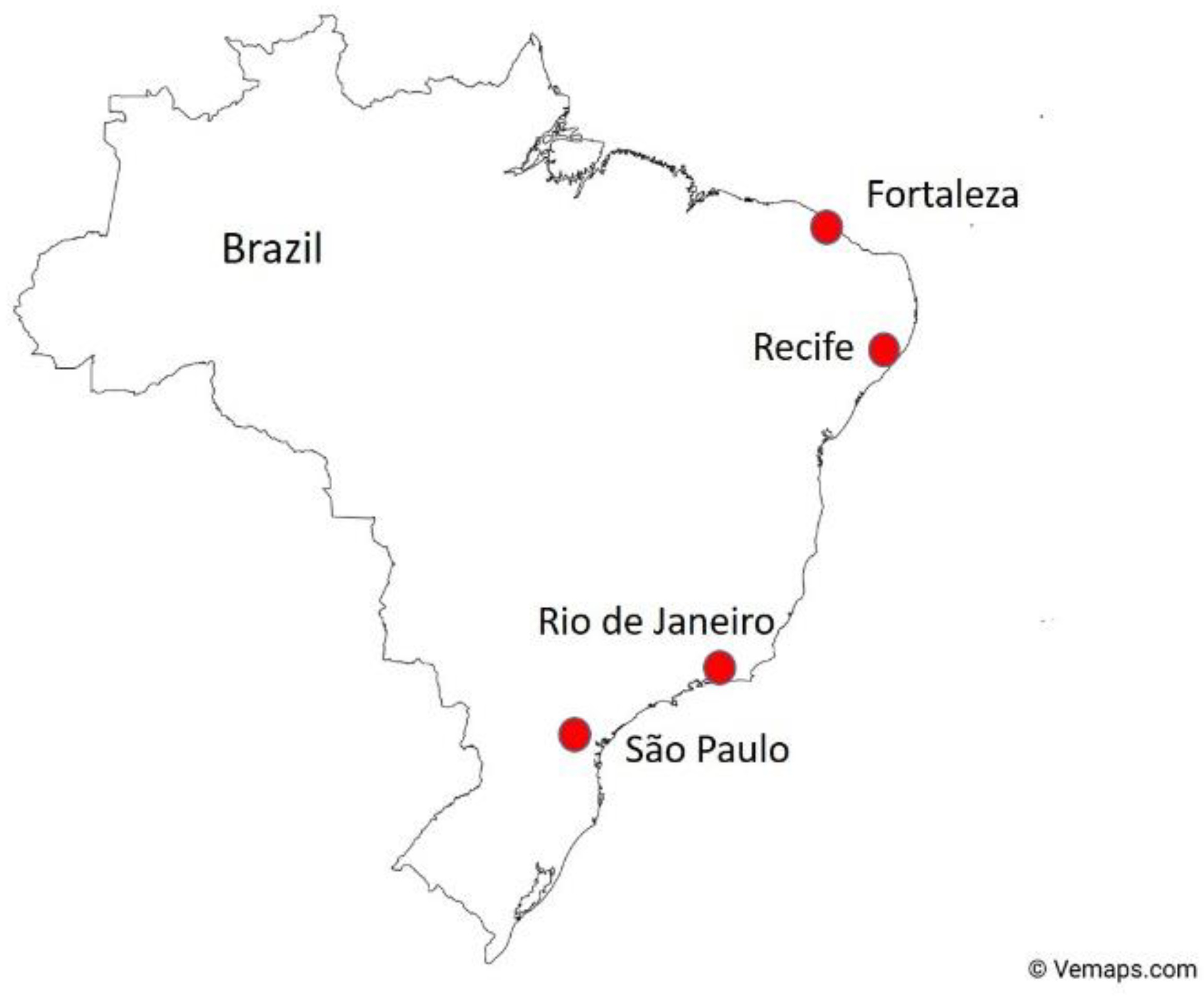
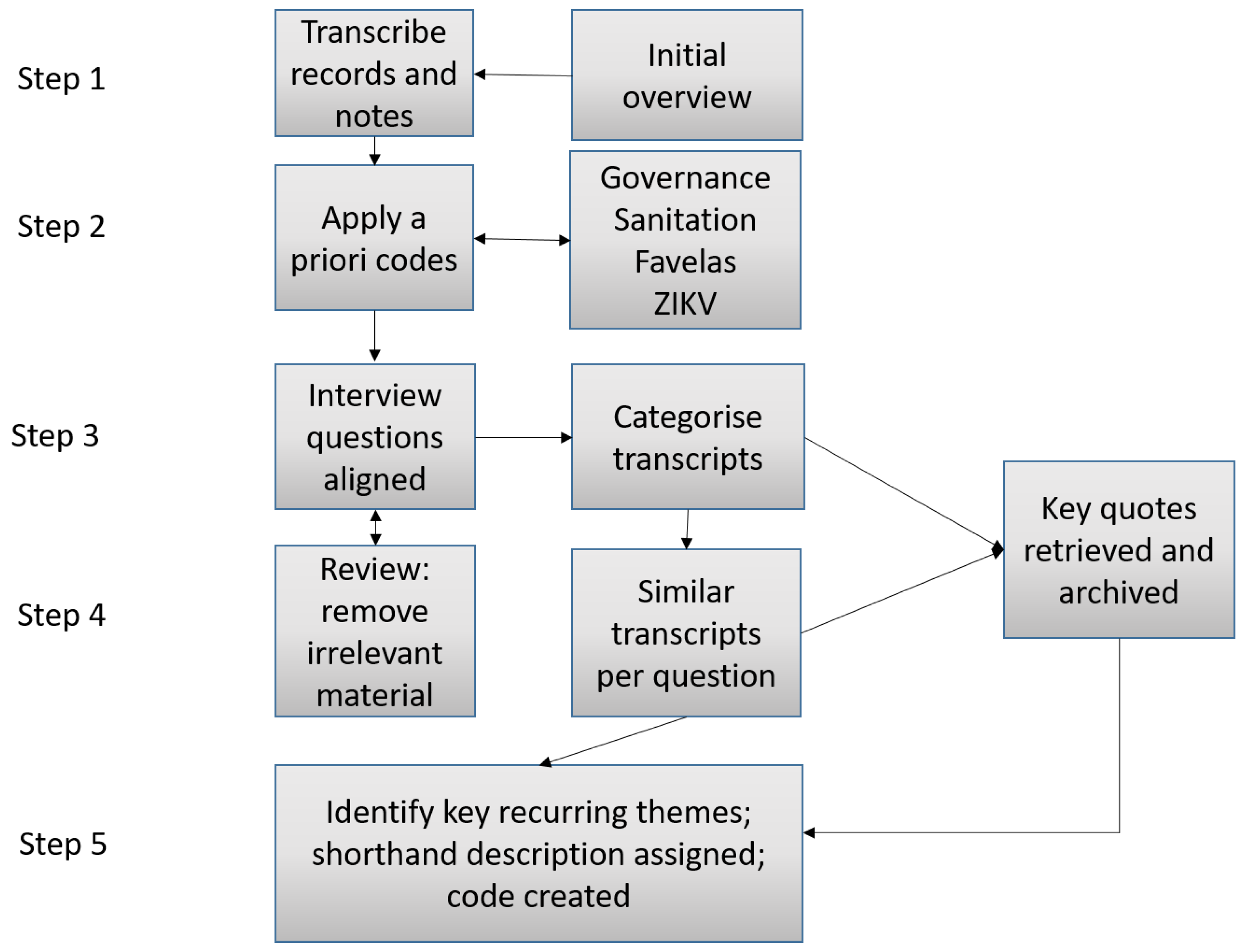
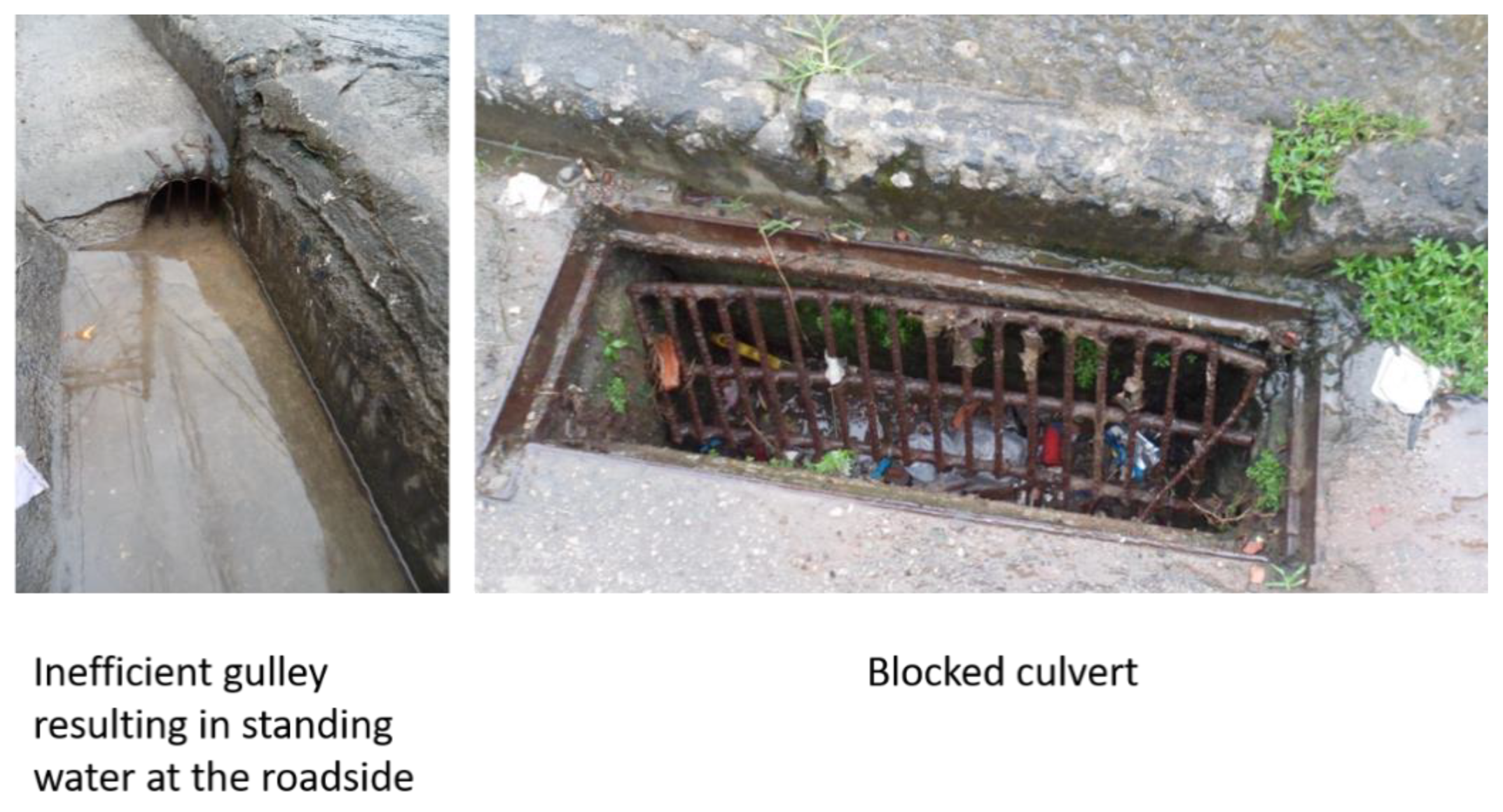
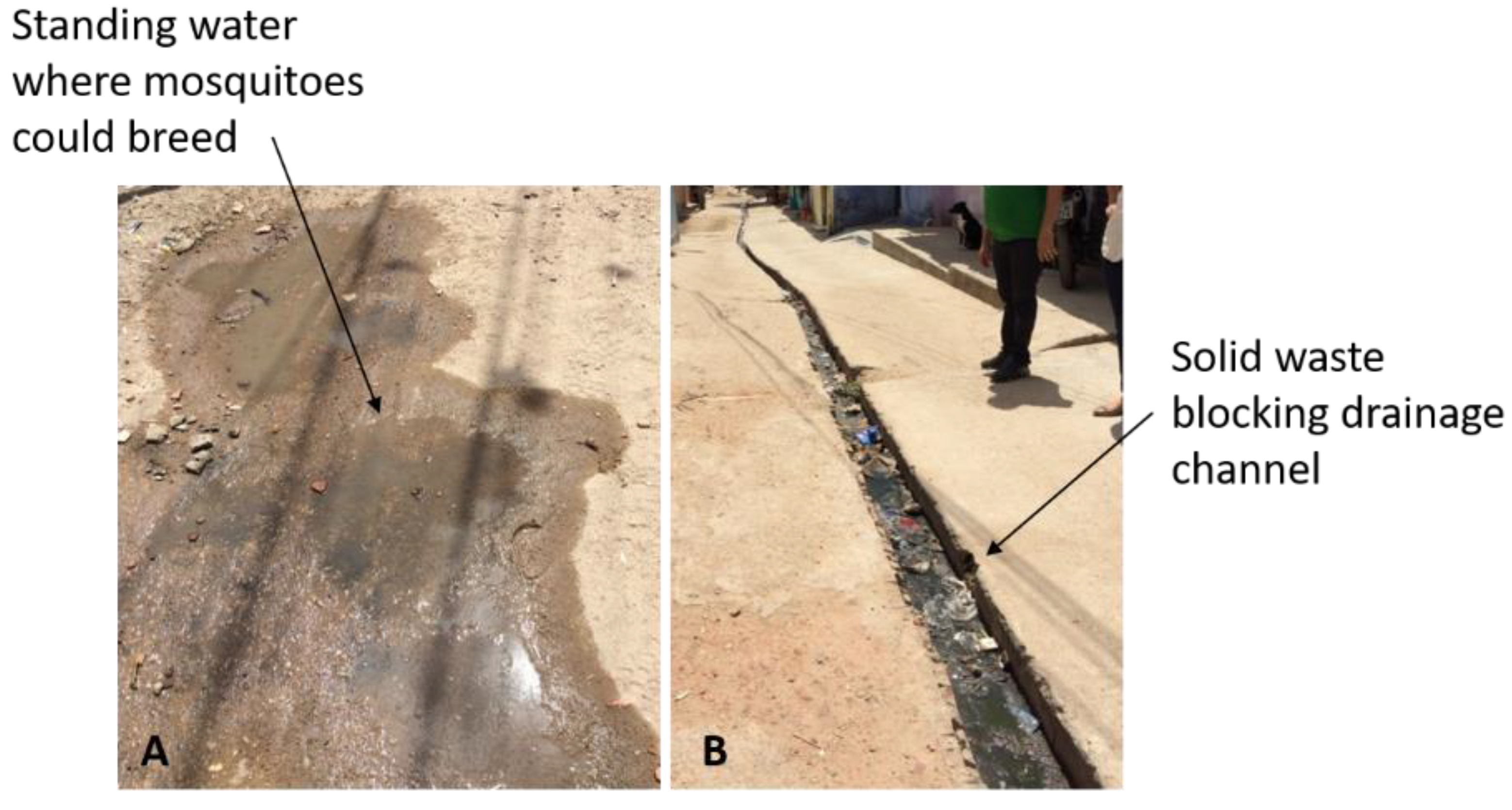
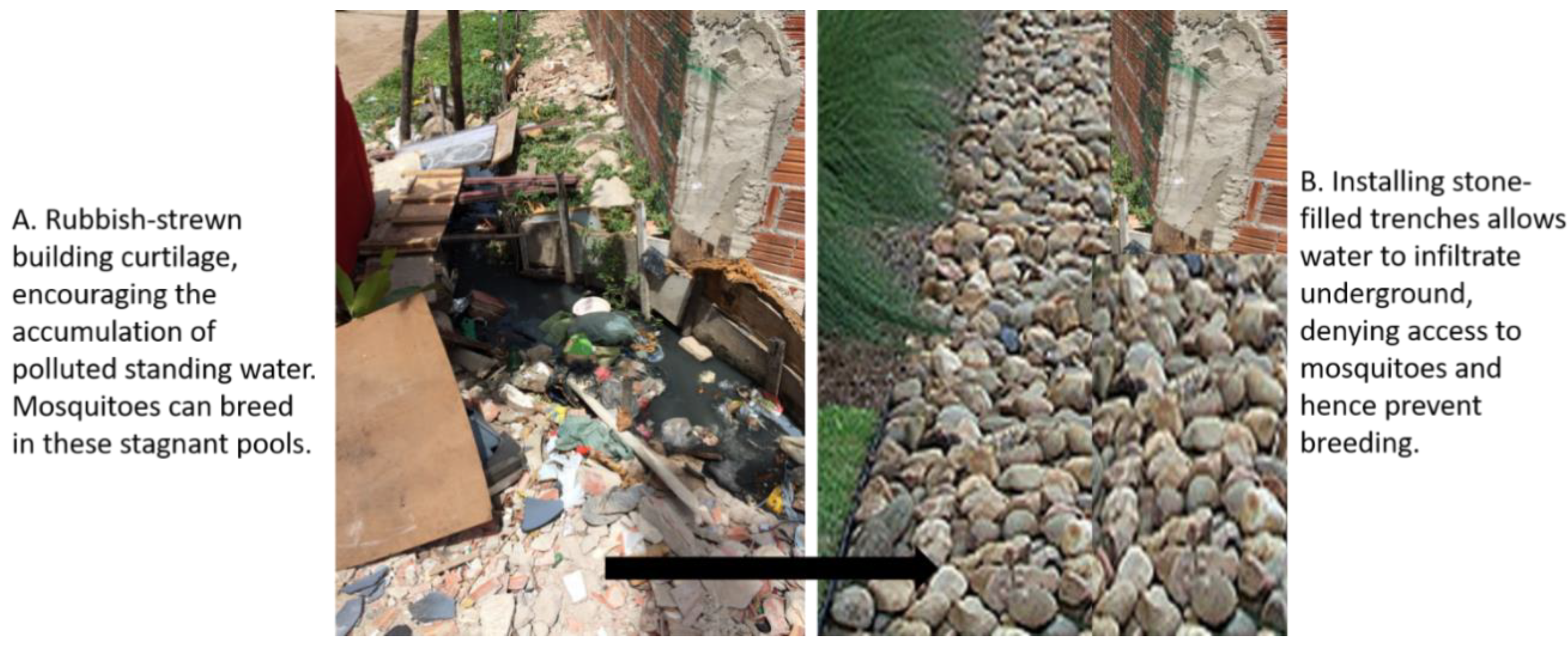
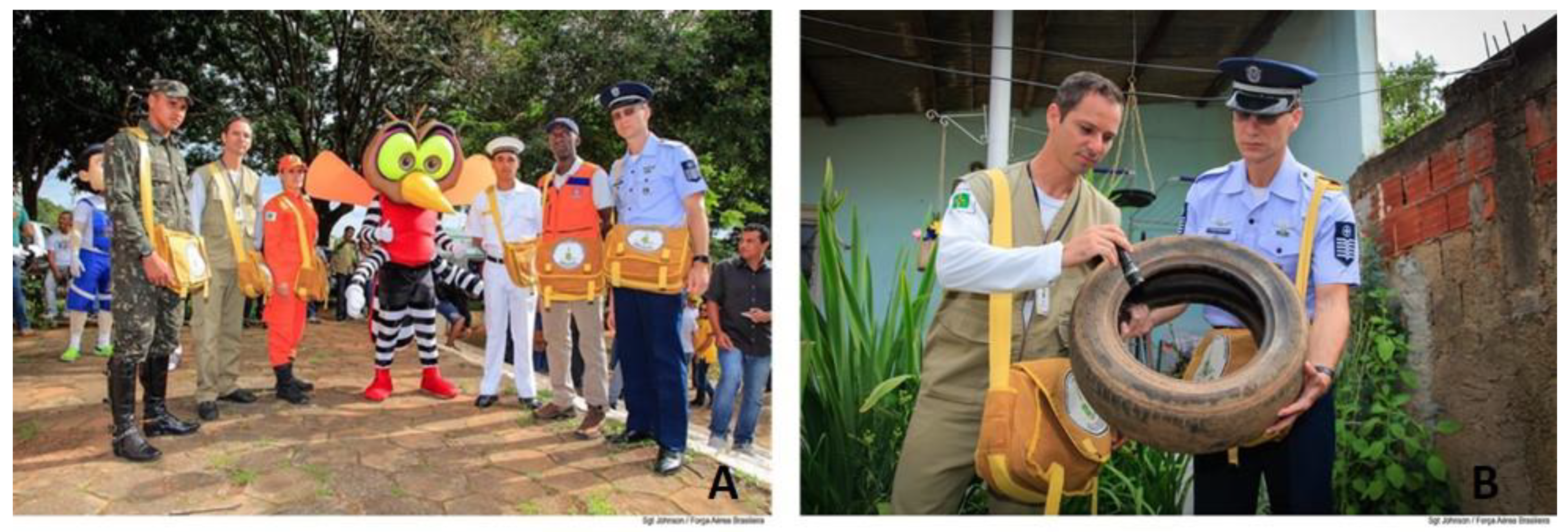
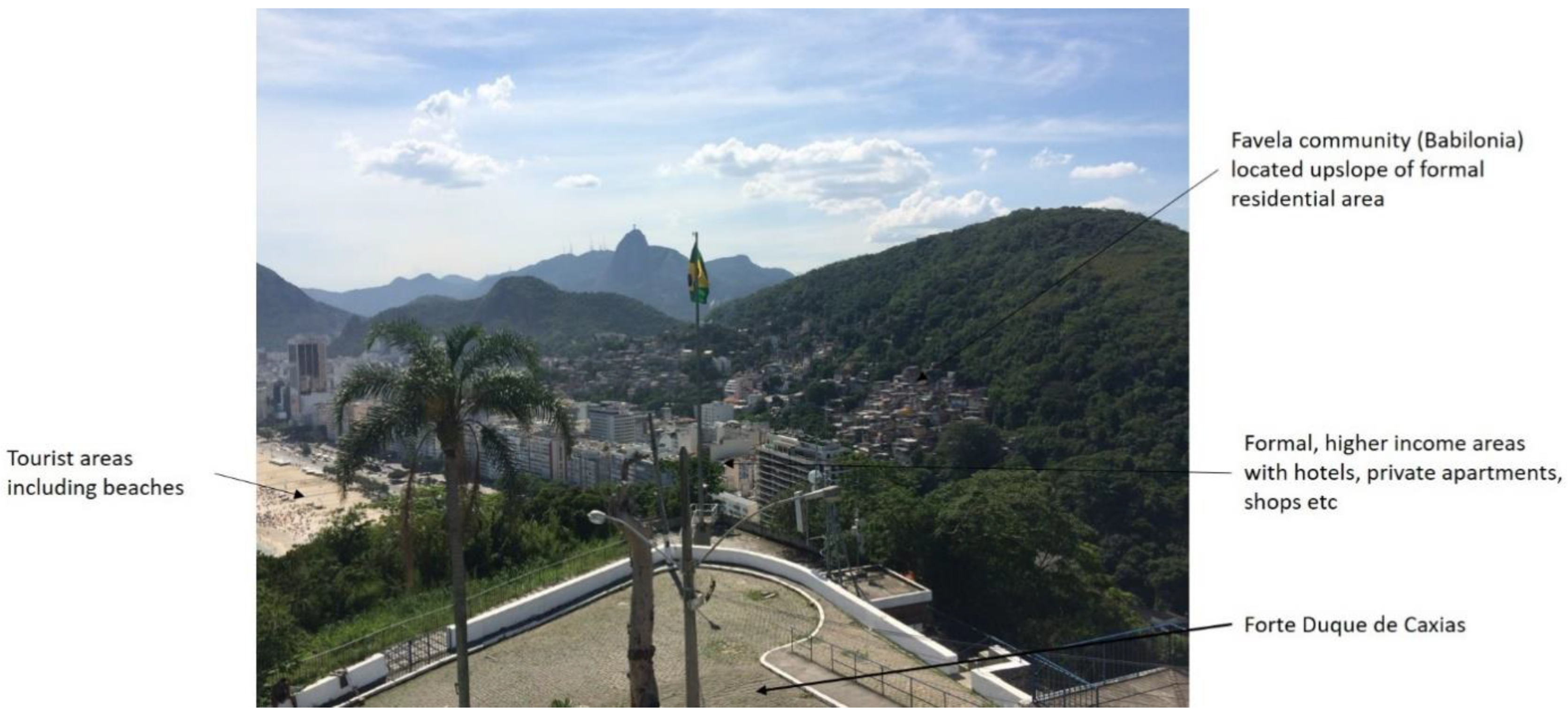
| Background of Participant | N° of Participants |
|---|---|
| Social Science | |
| Analyst: Health Management | 1 |
| Researcher | 2 |
| Natural Science | |
| Technologist | 2 |
| Subject specialist | 1 |
| Sanitary Engineer | 1 |
| Researcher | 2 |
| Laboratory Technician | 1 |
| Health Workers | |
| Community Health | 1 |
| Nurse | 1 |
| Government Employees | |
| Subject specialist | 1 |
| Technician | 1 |
| Favela Community | 2 |
| Total | 16 (9 women/7 men) |
Publisher’s Note: MDPI stays neutral with regard to jurisdictional claims in published maps and institutional affiliations. |
© 2022 by the authors. Licensee MDPI, Basel, Switzerland. This article is an open access article distributed under the terms and conditions of the Creative Commons Attribution (CC BY) license (https://creativecommons.org/licenses/by/4.0/).
Share and Cite
Charlesworth, S.M.; Kligerman, D.C.; Blackett, M.; Warwick, F. The Potential to Address Disease Vectors in Favelas in Brazil Using Sustainable Drainage Systems: Zika, Drainage and Greywater Management. Int. J. Environ. Res. Public Health 2022, 19, 2860. https://doi.org/10.3390/ijerph19052860
Charlesworth SM, Kligerman DC, Blackett M, Warwick F. The Potential to Address Disease Vectors in Favelas in Brazil Using Sustainable Drainage Systems: Zika, Drainage and Greywater Management. International Journal of Environmental Research and Public Health. 2022; 19(5):2860. https://doi.org/10.3390/ijerph19052860
Chicago/Turabian StyleCharlesworth, Susanne M., Debora C. Kligerman, Matthew Blackett, and Frank Warwick. 2022. "The Potential to Address Disease Vectors in Favelas in Brazil Using Sustainable Drainage Systems: Zika, Drainage and Greywater Management" International Journal of Environmental Research and Public Health 19, no. 5: 2860. https://doi.org/10.3390/ijerph19052860
APA StyleCharlesworth, S. M., Kligerman, D. C., Blackett, M., & Warwick, F. (2022). The Potential to Address Disease Vectors in Favelas in Brazil Using Sustainable Drainage Systems: Zika, Drainage and Greywater Management. International Journal of Environmental Research and Public Health, 19(5), 2860. https://doi.org/10.3390/ijerph19052860








